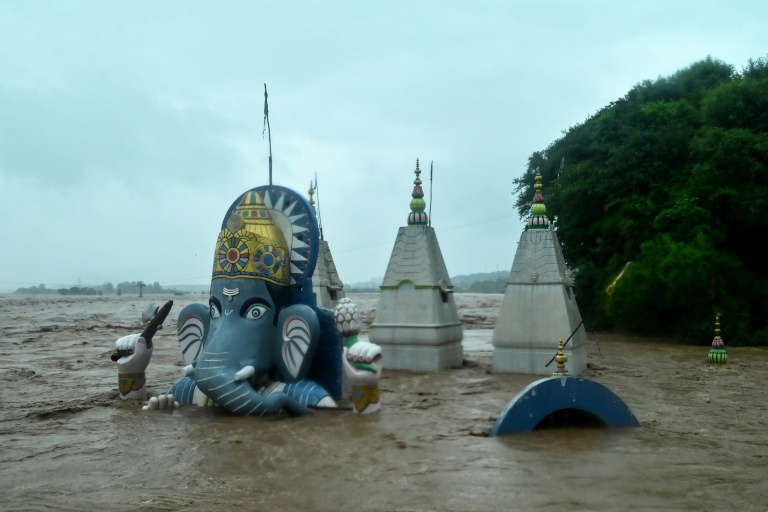World
Floods and Landslides Claim 30 Lives in Jammu and Kashmir

Heavy rains have led to devastating floods and landslides in the Himalayan region of Jammu and Kashmir, resulting in at least 30 fatalities. Local officials and media reported the tragic incidents on Wednesday, August 16, 2023. The torrential monsoon rains wreaked havoc across the area, causing significant destruction as raging waters breached bridges and inundated homes.
A landslide along the route to the renowned Hindu shrine, Vaishno Devi, was particularly catastrophic, claiming the majority of the lives lost. The local disaster management team confirmed the figures to the news agency AFP. Prime Minister Narendra Modi expressed his sorrow over the loss of life, describing the situation as “saddening.”
Climate Change and Increased Risks
Flooding and landslides are not uncommon during the June to September monsoon season in this region. Yet, climate experts indicate that the risks have significantly escalated due to climate change and poorly planned urban development. According to the International Centre for Integrated Mountain Development (ICIMOD), the combination of extreme rainfall and destabilized mountain slopes—largely a result of melting permafrost—exacerbates the impact of such disasters.
In a recent statement, ICIMOD highlighted that the broader Hindu Kush Himalaya region is experiencing “accelerated glacier melt, shifting weather patterns, and an increasing frequency of disaster events” such as these floods. The local administration reported that thousands have been compelled to evacuate their homes in the Jammu area, with schools closing due to the ongoing crisis. Chief Minister Omar Abdullah noted that officials are facing challenges with “almost nonexistent communication,” complicating relief efforts.
As the situation develops, the main Jhelum River in the Kashmir valley has risen above safety levels, prompting authorities to issue flood alerts for key areas, including the city of Srinagar.
Previous Incidents Highlight Growing Concerns
The recent events follow a series of deadly incidents in the region. On August 14, intense rainfall resulted in powerful torrents striking Chisoti village in Indian-administered Kashmir, leaving at least 65 people dead and 33 others missing. Just days earlier, on August 5, a similar disaster in the Himalayan town of Dharali, located in Uttarakhand state, overwhelmed the area, burying it in mud and likely leading to over 70 fatalities.
The recurring nature of these tragedies raises urgent questions about disaster preparedness and climate resilience in the region. As officials work to assess damage and provide assistance, the immediate focus remains on rescuing those affected and restoring communication and infrastructure in Jammu and Kashmir.
-

 Politics4 weeks ago
Politics4 weeks agoSecwepemc First Nation Seeks Aboriginal Title Over Kamloops Area
-

 World5 months ago
World5 months agoScientists Unearth Ancient Antarctic Ice to Unlock Climate Secrets
-

 Entertainment5 months ago
Entertainment5 months agoTrump and McCormick to Announce $70 Billion Energy Investments
-

 Science5 months ago
Science5 months agoFour Astronauts Return to Earth After International Space Station Mission
-

 Lifestyle5 months ago
Lifestyle5 months agoTransLink Launches Food Truck Program to Boost Revenue in Vancouver
-

 Technology3 months ago
Technology3 months agoApple Notes Enhances Functionality with Markdown Support in macOS 26
-

 Lifestyle3 months ago
Lifestyle3 months agoManitoba’s Burger Champion Shines Again Amid Dining Innovations
-

 Top Stories2 months ago
Top Stories2 months agoUrgent Update: Fatal Crash on Highway 99 Claims Life of Pitt Meadows Man
-

 Politics4 months ago
Politics4 months agoUkrainian Tennis Star Elina Svitolina Faces Death Threats Online
-

 Sports5 months ago
Sports5 months agoSearch Underway for Missing Hunter Amid Hokkaido Bear Emergency
-

 Politics5 months ago
Politics5 months agoCarney Engages First Nations Leaders at Development Law Summit
-

 Technology5 months ago
Technology5 months agoFrosthaven Launches Early Access on July 31, 2025





















